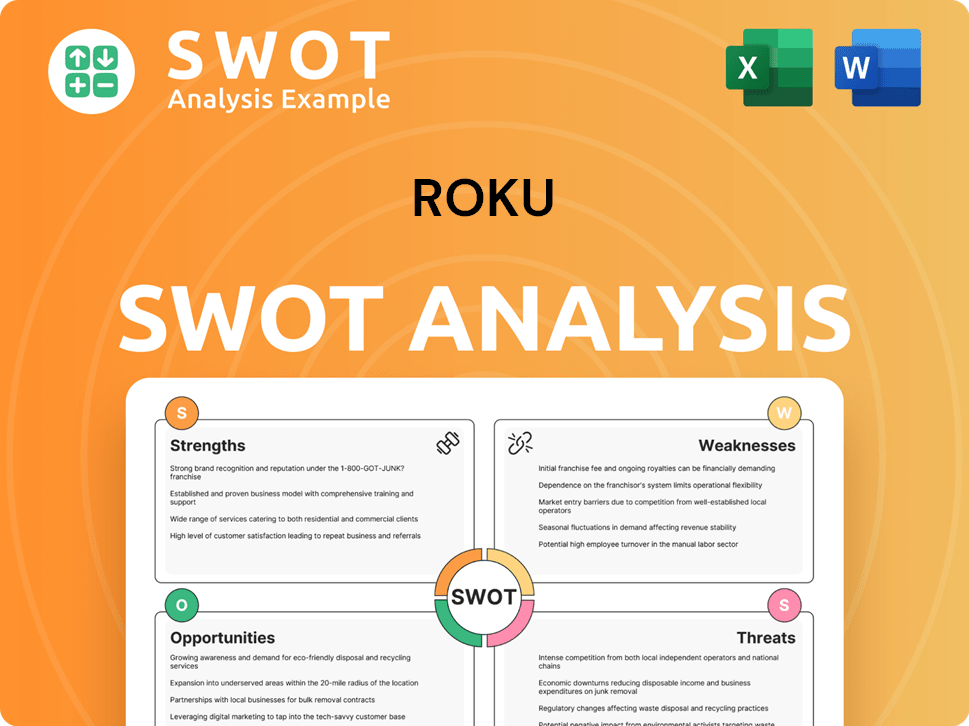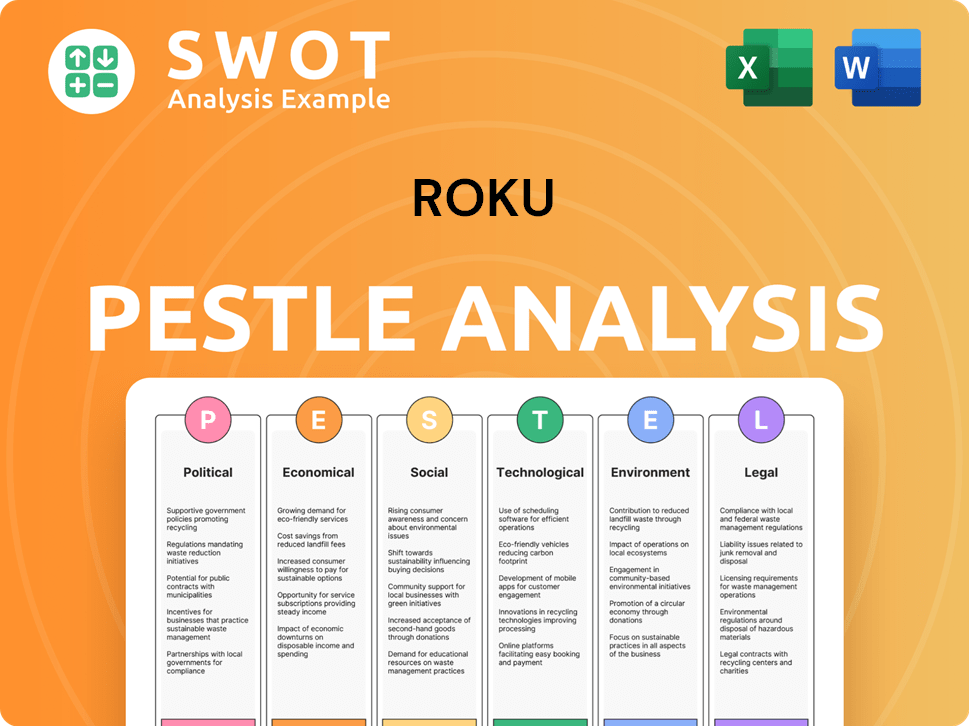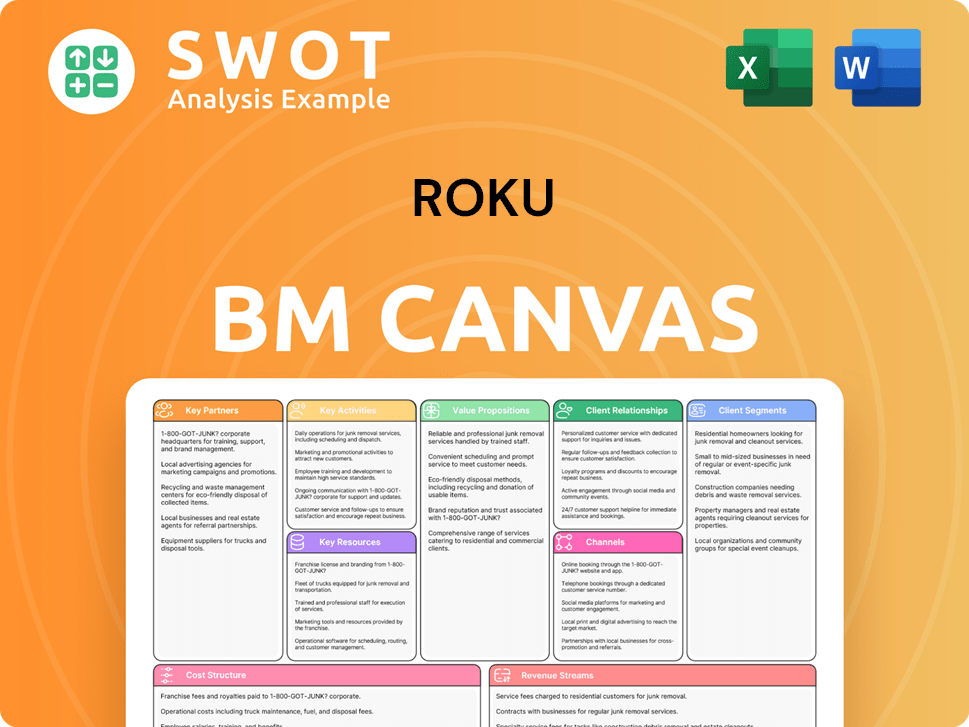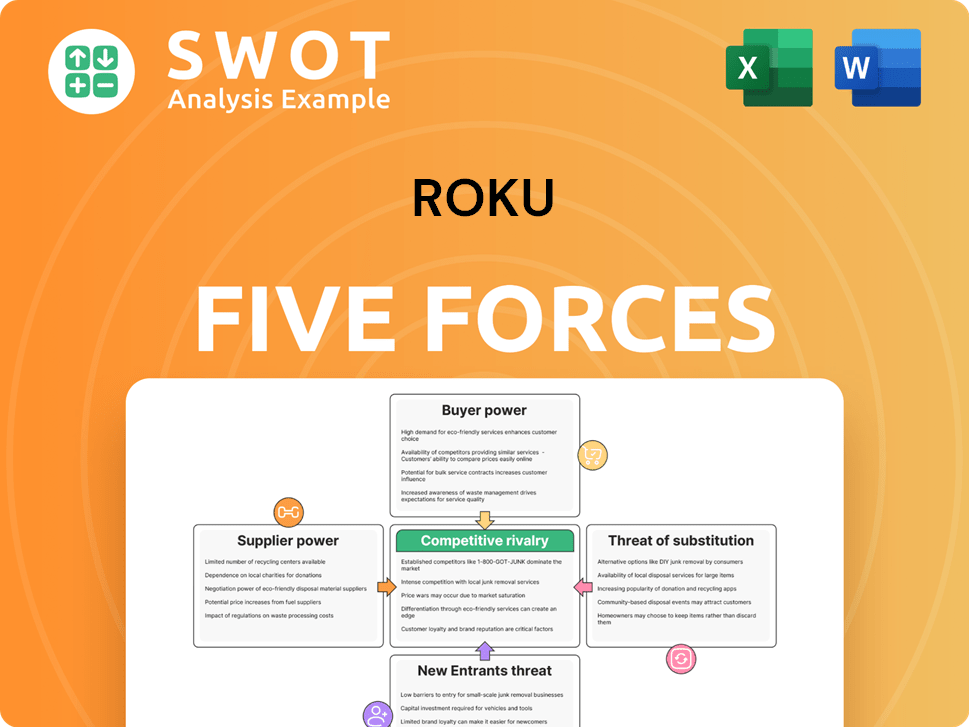Roku Bundle
Who's Winning the Streaming Wars Against Roku?
Roku revolutionized how we watch TV, but the streaming landscape is a battlefield. Founded in 2002, Roku's journey from a simple set-top box to a leading streaming platform provider has been nothing short of remarkable. But with so many players vying for viewers' attention, how does Roku stack up?

To truly understand Roku's position, we must delve into its rivals and the strategies it employs to maintain its edge. This analysis will explore Roku SWOT Analysis, examining its competitive advantages and disadvantages, and how it navigates the ever-changing world of streaming services. We'll analyze Roku's market share, compare it against its competitors, and assess its growth potential in the streaming market, providing actionable insights for investors and industry watchers alike. The Roku competitive landscape is complex, but understanding it is key.
Where Does Roku’ Stand in the Current Market?
Roku maintains a robust market position within the streaming industry, primarily through its widely adopted streaming platform and devices. As of Q1 2024, the company reported 81.6 million active accounts, showcasing its substantial reach in the connected TV market. Its core operations revolve around streaming players, smart TVs powered by the Roku OS, and an advertising-driven platform.
The company generates revenue through programmatic advertising, content distribution, and subscription services. Historically, Roku has shifted its positioning from a hardware-focused company to a platform-centric business. This strategic pivot has allowed Roku to diversify its revenue streams, with platform revenue becoming the dominant contributor.
Roku's geographic presence is predominantly in North America, though it has been expanding internationally. This strategic move has enabled Roku to diversify its revenue streams, with platform revenue (primarily advertising and content distribution) becoming the dominant contributor. In Q1 2024, platform revenue accounted for $726 million, significantly outweighing device revenue of $84.4 million. This shift highlights Roku's successful digital transformation, moving beyond hardware sales to capitalize on the lucrative advertising and content aggregation market.
Roku holds a significant share of the streaming device market, especially in North America. The company's market share fluctuates but remains competitive against rivals like Amazon Fire TV, Google Chromecast, and Apple TV. Understanding the Roku market share is crucial for assessing its competitive standing.
Roku's revenue model is diversified, with platform revenue (advertising, content distribution) being the primary driver. Device sales contribute, but platform revenue is more significant. Roku's financial performance is closely tied to its ability to attract users and monetize its platform. For further insights, consider the Growth Strategy of Roku.
Roku's competitive advantages include its user-friendly interface, wide content selection, and competitive pricing. The Roku OS is also integrated into many smart TVs, expanding its reach. These factors contribute to its strong position in the Roku competitive landscape.
Challenges for Roku include intense competition from other streaming devices and OTT platforms. Dependence on advertising revenue and the need to continuously innovate are also significant. Understanding these challenges is critical for evaluating Roku's long-term prospects.
Roku's position in the streaming market is strong, with a significant user base and a diversified revenue model. Its focus on platform revenue, particularly advertising, is a key differentiator. The company's ability to compete with major players like Amazon, Apple, and Google determines its future success.
- Strong user base and active accounts.
- Diversified revenue streams (platform and devices).
- Competitive pricing and user-friendly interface.
- Challenges from major competitors and market trends.
Roku SWOT Analysis
- Complete SWOT Breakdown
- Fully Customizable
- Editable in Excel & Word
- Professional Formatting
- Investor-Ready Format

Who Are the Main Competitors Challenging Roku?
The Roku competitive landscape is multifaceted, encompassing hardware, software, and advertising. Understanding its key competitors is crucial for assessing its market position and growth potential. The company faces competition across various segments, from streaming devices to the broader platform and advertising markets.
Direct competitors in the streaming device market include Amazon with its Fire TV, Google with Chromecast and Android TV, and Apple with Apple TV. These companies leverage their existing ecosystems and brand recognition to attract users. In the platform and advertising space, the competition extends to major streaming services like Netflix, Disney+, and Hulu, which also vie for consumer attention and advertising revenue. Furthermore, traditional media companies and new entrants are increasing the competitive pressure.
The streaming device market is highly competitive. According to recent reports, in the United States, the company holds a significant market share, but faces strong competition from Amazon's Fire TV and other platforms. In Q1 2024, the company's platform revenue grew, indicating its ability to monetize its user base effectively. However, the growth rate is influenced by the overall market dynamics and the strategies of its competitors.
Amazon's Fire TV is a major competitor, leveraging its e-commerce ecosystem and Alexa integration. Google's Chromecast and Android TV benefit from the widespread adoption of Android. Apple TV targets a premium segment, integrating seamlessly with Apple's services.
Major streaming services like Netflix, Disney+, and Hulu compete for consumer attention and advertising dollars. Traditional media companies and broadcasters are developing their own direct-to-consumer streaming apps. New entrants, such as FAST channels, also contribute to the competitive landscape.
Amazon often bundles Fire TV devices with Prime subscriptions, offering a compelling value proposition. Google leverages its vast content ecosystem through Google Play. Apple TV focuses on a premium user experience and integration with its services.
Mergers and alliances, such as the Warner Bros. Discovery and Paramount Global streaming bundles, reshape competitive dynamics. The rise of FAST channels and AVOD services fragments the advertising market. The overall market growth is influenced by consumer preferences and content availability.
The company's platform revenue growth is a key indicator of its success in the advertising market. Device sales contribute to overall revenue, but the platform segment is often more profitable. The financial performance is compared to competitors like Amazon and Google.
The competitive landscape is constantly evolving, with new entrants and changing consumer preferences. The growth of streaming services and the shift towards AVOD models will continue to shape the market. Partnerships and collaborations will play a crucial role in the future.
The company's success depends on its ability to differentiate itself from competitors. Understanding the strategies of key players is crucial for strategic planning. The competition extends beyond just streaming devices to include platform and advertising revenue.
- Amazon Fire TV: Bundling with Prime, extensive e-commerce integration, and Alexa voice control.
- Google Chromecast/Android TV: Leveraging the Android ecosystem, Google Play content, and smart home integration.
- Apple TV: Premium hardware, seamless integration with Apple services, and a focus on user experience.
- Netflix, Disney+, Hulu: Investing heavily in exclusive content to attract subscribers and advertising revenue.
- Smart TV Manufacturers: Offering integrated smart TV platforms, often with their own app stores and content recommendations.
Roku PESTLE Analysis
- Covers All 6 PESTLE Categories
- No Research Needed – Save Hours of Work
- Built by Experts, Trusted by Consultants
- Instant Download, Ready to Use
- 100% Editable, Fully Customizable

What Gives Roku a Competitive Edge Over Its Rivals?
Roku's competitive advantages are primarily rooted in its platform's agnostic approach, its proprietary operating system, and strong brand recognition. This strategy allows it to offer a comprehensive streaming hub, attracting a wide range of consumers. The company's focus on advertising technology also sets it apart, allowing it to monetize its large user base effectively. Understanding the Marketing Strategy of Roku provides further insights into its competitive positioning.
Unlike competitors tied to specific content ecosystems, Roku's platform is designed to be content-agnostic, offering access to a vast array of streaming services. This neutrality has fostered broad content availability, making Roku an attractive choice for consumers seeking a comprehensive streaming hub. The company's focus on advertising technology and programmatic ad sales on its platform also sets it apart, allowing it to monetize its large user base effectively.
Roku's brand equity, built over years of being a pioneer in the streaming device market, contributes to its customer loyalty. The company has consistently introduced new features and improved its offerings, such as enhanced search capabilities and voice control, to maintain user engagement. While these advantages are substantial, they face threats from imitation by competitors developing their own smart TV platforms and the increasing consolidation of content within rival ecosystems.
Roku's platform is designed to be content-agnostic, offering users access to a vast array of streaming services without prioritizing its own content. This neutrality fosters broad content availability. This approach makes Roku an attractive choice for consumers seeking a comprehensive streaming hub, setting it apart in the Roku competitive landscape.
The Roku OS is a significant advantage, providing an intuitive and user-friendly interface that has garnered strong customer loyalty. Roku licenses its OS to various TV manufacturers, expanding its reach and embedding its platform directly into smart TVs. This strategy creates an expansive installed base, attracting more content providers and advertisers.
Roku's focus on advertising technology and programmatic ad sales on its platform allows it to monetize its large user base effectively. Platform revenue, largely driven by advertising, was $726 million in Q1 2024, showcasing the strength of this advantage. This focus is crucial in the Roku player market analysis.
Roku's brand equity, built over years as a pioneer in the streaming device market, contributes to its customer loyalty. The company consistently introduces new features and improves its offerings, such as enhanced search capabilities and voice control, to maintain user engagement. This helps Roku maintain its position in the streaming market.
Roku's primary competitive advantages include its content-agnostic platform, proprietary Roku OS, and strong advertising capabilities. These factors contribute to its market position. The company's strategy for market dominance involves continuous innovation and strategic partnerships.
- Content-Agnostic Platform: Offers a wide array of streaming services.
- Proprietary Roku OS: Provides a user-friendly experience and broad reach.
- Advertising Revenue: Drives significant platform revenue.
- Brand Equity: Built over years of being a pioneer in the streaming device market.
Roku Business Model Canvas
- Complete 9-Block Business Model Canvas
- Effortlessly Communicate Your Business Strategy
- Investor-Ready BMC Format
- 100% Editable and Customizable
- Clear and Structured Layout

What Industry Trends Are Reshaping Roku’s Competitive Landscape?
The streaming industry's competitive landscape is dynamic, with trends constantly reshaping the strategies of major players like Roku. Understanding the current position, potential risks, and future outlook is crucial for investors and industry analysts. The market is influenced by technological advancements, shifting consumer preferences, and regulatory changes. For example, the growth of 4K and 8K streaming technologies and the increasing demand for personalized content are key drivers.
Roku's competitive position is affected by factors such as the "streaming wars," high content costs, and the potential impact of economic downturns on advertising revenue. The company faces challenges from tech giants with vast resources and the need to attract and retain users in a fragmented market. Understanding these elements is vital for assessing Roku's potential for long-term success.
The streaming industry is experiencing rapid technological advancements, including 4K and 8K streaming, which are enhancing user experiences. Consumer preferences are shifting towards ad-supported content, as seen with the rise of FAST channels. Regulatory changes, particularly regarding data privacy and advertising, are also influencing the market.
Roku faces intense competition from major tech companies with significant resources and integrated ecosystems. The "streaming wars" drive high content costs, complicating user acquisition and retention. Economic downturns could negatively affect advertising spending, impacting revenue. Increased digital advertising regulations pose a threat.
The continued global adoption of streaming provides a large addressable market for Roku, especially in emerging regions. Further innovation in advertising technology, such as improved targeting and measurement, can enhance appeal to advertisers. Strategic partnerships with content providers and smart TV manufacturers offer new growth avenues.
Roku's competitive landscape is defined by its dual strategy of hardware and platform. It balances the complexities of content licensing and leverages its advertising capabilities. The company must navigate these elements to remain resilient in a dynamic industry. To learn more, you can check out an article about the Roku's main competitors in 2024.
Roku's advantages include its strong platform, extensive content library, and integrated advertising capabilities. Its disadvantages involve intense competition from well-funded rivals, high content costs, and the potential impact of economic downturns on advertising revenue. Navigating these advantages and disadvantages is key to Roku's strategic planning.
- Roku's market share in the streaming device market is significant, but it faces strong competition from Amazon's Fire TV, Google's Chromecast, and Apple TV.
- The company's financial performance is closely tied to advertising revenue, which can fluctuate with economic cycles.
- Roku's ability to innovate in advertising technology and form strategic partnerships will be crucial for its future growth.
- The evolution of streaming service market trends, including the rise of ad-supported models, presents both opportunities and challenges.
Roku Porter's Five Forces Analysis
- Covers All 5 Competitive Forces in Detail
- Structured for Consultants, Students, and Founders
- 100% Editable in Microsoft Word & Excel
- Instant Digital Download – Use Immediately
- Compatible with Mac & PC – Fully Unlocked

Related Blogs
- What are Mission Vision & Core Values of Roku Company?
- What is Growth Strategy and Future Prospects of Roku Company?
- How Does Roku Company Work?
- What is Sales and Marketing Strategy of Roku Company?
- What is Brief History of Roku Company?
- Who Owns Roku Company?
- What is Customer Demographics and Target Market of Roku Company?
Disclaimer
All information, articles, and product details provided on this website are for general informational and educational purposes only. We do not claim any ownership over, nor do we intend to infringe upon, any trademarks, copyrights, logos, brand names, or other intellectual property mentioned or depicted on this site. Such intellectual property remains the property of its respective owners, and any references here are made solely for identification or informational purposes, without implying any affiliation, endorsement, or partnership.
We make no representations or warranties, express or implied, regarding the accuracy, completeness, or suitability of any content or products presented. Nothing on this website should be construed as legal, tax, investment, financial, medical, or other professional advice. In addition, no part of this site—including articles or product references—constitutes a solicitation, recommendation, endorsement, advertisement, or offer to buy or sell any securities, franchises, or other financial instruments, particularly in jurisdictions where such activity would be unlawful.
All content is of a general nature and may not address the specific circumstances of any individual or entity. It is not a substitute for professional advice or services. Any actions you take based on the information provided here are strictly at your own risk. You accept full responsibility for any decisions or outcomes arising from your use of this website and agree to release us from any liability in connection with your use of, or reliance upon, the content or products found herein.